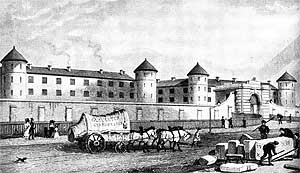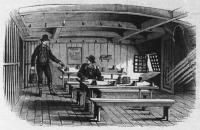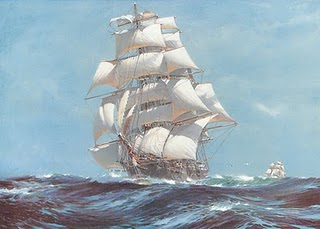|
WILLIAM
HUDGELL
BORN: Circa. 1792-1851
Sawbridgeworth,
Hertfordshire
PARENTS: WILLIAM
HUDGELL and MARY ELDRIDGE
William's life of crime started from a very
young age, in 1804 at the age of just 12 he was tried for stealing a parcel
but was acquitted.
In 1825 he was tried for
stealing a rabbit and 2/- and was proved guilty and sentenced to
transportation but this never occurred.
In October 1830
he was charged again for stealing two hurdles and several other pieces
of wood for this he served 3 years and 4 months at the bridewell and was
whipped.
Finally in 1835
at the age of 43 he was convicted of larceny and transported to VDL for
life.
Arriving in
Tasmania on the ship
Elphinstone in mid
1836.
Within 6 months
in December of that year he was in trouble again for absconding
from
Glenarchy road party and was sentences to
six
months hard labour in chains.
Three years later in 1839 he served 10 days solitary confinement on
bread and water for being drunk and disorderly in charge of a team of
horses.
In
1840 he was absent without leave under suspicion of robbery and
harbouring for which he got 6 months hard labour
He
was given his Ticket of Leave in 1849.
He
was married to May Hopkins (or at least she was his common-law wife who
died just before his last crime in England in Hertfordshire in 1835.
CRIMINAL REGISTER:
|
 |
At the age of 12 stole a parcel
1804 Jan 3 - 1805 May 11
Correspondence and warrants
1804-5 William Hudgell prisoner, home office,
conditional pardon
Source
Citation:
PRO HO 13/16 |
|
 |
1825
– Hertfordshire Summer Assizes, William Hudgell
from Gilston, 7 Years
Transportation, but not transported,
crime, larceny – a tame rabbit, and 2 shillings (approx £6 in
today’s money 2011) the property of William Culver |
|
 
|
1830
– Hertfordshire Epiphany Sessions,
Presentment Book,
Volume 2
pp. 278 – 280
Gaol
and Bridewell calendars:
Indictments William Hudgell of Saridgeworth
(Sawbridgeworth) labourer, for stealing two hurdles, value 1s.,
and 10 pieces of wood, value 1s from Thomas Chapman……
Hudgell had previously been convicted of Felony
served 3 years and 4
months at Bridewell and whipped
 |
|
Title: |
Commitments to the County Gaol
|
|
Source: |
Hertfordshire Mercury page 2
|
|
Publication date: |
9 January 1830 |
|
Subjects: |
Convicts |
|
Places: |
Hertfordshire |
|
Personal names: |
John Cooper ; George Potter ; James Warwick ;
Thomas Harding ;
William Hudgell
|
|
Source: |
Hertfordshire Mercury page 3
|
|
Publication date: |
16 January 1830 |
|
Subjects: |
Crime; Quarter Epiphany sessions
|
|
Places: |
Sawbridgeworth |
|
Herts Epiphany Sessions : Prisoners - theft of
hurdles |
Hertfordshire Mercury page 3 |
16 January 1830 |
|
|
|
 |
Millbank
Penitentiary nr. Vauxhall London.
Every
male and female convict sentenced to
transportation in Great Britain is sent to Millbank
previous to the sentence being executed. Here they remain about
three months under the close inspection of the three inspectors of
the prison, at the end of which time the inspectors report to the
Home Secretary, and recommend the place of transportation.

Millbank
Penitentiary |
|
 |
1835
– 4 March 1835, William Hudgell, aged 42, born about 1793, Larceny,
No prosecution, Acquitted |
|
Title: |
Commitments to the Hertford County Gaol
|
|
Source: |
County Press page 2 |
|
Publication date: |
10/10/1835 |
|
Subjects: |
Convicts |
|
Personal names: |
William Hudgell
; James Johnson ; James Miles ; John Briggs ; Joseph Ford ; John
Charles ; James Hankin ; John Ansell ; Henry Cain ; |
|
 |
1835 MICHAELMAS SESSION
RECOGNIZANCE BOOK
1835
– 10 October 1835
Volume 2 pp. 95-197
Recognisance’s entered into:
William Hudgell, age 43
born about 1793 can neither read nor write, Larceny,
from Cheshunt, labourer, life
sentence, transported on the ship Elphinstone, crime larceny –
stealing hay, value 3d, a spade worth 1 shilling and a pitchfork
worth 6 pence property of Elizabeth Jessopp, widow. (Convicted
before of
Felony,
transported for life)
|
|
Title: |
Herts Quarter Sessions : Stealing a spade and fork
|
|
Source: |
County Press page 4 |
|
Publication date: |
24/10/1835 |
|
Subjects: |
Quarter sessions |
|
Personal names: |
William Hudgell |
|
 |
1836 EPIPHANY SESSION
p. 387 Cost of prosecuting, etc.
The court forwarded the following particulars to the
Secretary of State: cost of criminal prosecutions at the Michaelmas
session, £131.17s., cost of conveying William Hudgell and Robert
Turner to Woolwich £4.8s.6d.
|
|
 |
HULK
REGISTER:
No
3265 - William Hudgell, aged 43, born about 1792, received onboard
prison hulk “Ganymede” moored at Woolwich and Devonport on 10
November 1835 from Hertford Gaol, convicted 19 October 1835 at
Hertford for stealing a spade and fork, sentenced to transportation
for Life, sent to VDL 12 January 1836

|
|
 |
|
 |
HMS Ganymede
1819-1838 was the French frigate Hébé captured in 1809.
She was converted to a prison hulk in 1819 and broken up in
1838.
The prison hulks filled a hole in the criminal
justice system following the end of transportation to North
America.
|
|
These ships sat on the Thames and in Plymouth
Harbour and provided a temporary home for thousands of
miscreants sentenced to transportation – from murderers to petty
thieves.
Many of the prisoners listed aboard the hulks were later
transported to Australia. |
 |
|
 |
Death and disease
Mortality rates of around 30% were quite common. Between 1776
and 1795, nearly 2000 out of almost 6000 convicts serving their
sentence on board the hulks died.
Many of the convicts sent to New South Wales in the early years
were already disease ridden when they left the hulks. As a
result, there were serious typhoid and cholera epidemics on many
of the vessels heading for Australia.
|
|
Convict dress
The men were poorly dressed as well as unhealthy. They were
supposed to have:
-
a linen shirt
-
a brown jacket
-
a pair of
breeches.
But the men who controlled the ships often pocketed the money
the government had given for the clothes.
|
 |
Food on the hulks
The authorities were always keen to keep down the cost of the
prisons. They wanted to avoid giving prisoners a better life
than the poor had outside the hulks.
The quality of the prisoners' food was therefore kept as low as
possible. The monotonous daily meals consisted chiefly of:
-
ox-cheek,
either boiled or made into soup
-
pease
-
bread or
biscuit.
The biscuits were often mouldy and green on both sides! On two
days a week the meat was replaced by oatmeal and cheese. Each
prisoner had two pints of beer four days a week, and badly
filtered water, drawn from the river, on the others.
By the 18th century the death penalty began to be
regarded as too severe a punishment for certain offences, such
as theft and larceny, and transportation to Australia became a
more usual form of sentence.
Convicts sentenced to transportation were sent
instead to ‘hulks’, old or un-seaworthy ships, generally ex-naval
vessels.
These floating prisons, operated by private
contractors, were used to house prisoners and convicts awaiting
transportation. Although originally introduced as a temporary
measure the hulks quickly became a cost efficient and integral
part of the British government’s response to an apparent
increase in crime during the late 18th and early 19th centuries.
From 1784, the British government passed
legislation authorising the transportation overseas of convicts
from the hulks and the notion of using hulks as floating prisons
was exported along with the convicts. Eventually convict hulks
were established in several British colonies.
|
|

Voyages in 1836
17 convict ships set sail in 1836.
4274 convicts transported in
1836
William Hudgell was one
of 240 Convicts Transported on “Elphinstone” 1836
Sentenced to Life at
Hertfordshire Quarter Sessions
Transported to Van
Diemen’s Land

- Convict No:
37864
- William
Hudgell
- Ship:
Elphinstone
- Departed:
Downs 30th January 1836
- Arrived:
Australia 24 May 1836
- Captain:
Thomas Fremlin
- Surgeon:
Colin Arrott Browning
- Destination:
Van Diemen’s Lane
-
Conduct Record: CON31/21
-
Description List: CON18/7, CON23/2
NAME:
WILLIAM HUDGELL
AGE:
43 on arrival in VDL
TRIED: 19
October 1835, Hertfordshire Quarter Sessions
SENTENCE: Life
CRIME:
Stealing a spade and fork
|
 |
SHIP:
Elphinstone (first voyage) – departed
London/Sheerness/ Downs 30 January 1836, arrived Hobart 24
May 1836, a voyage of 115 days, carrying 240 male convicts (238
landed). Master Thomas Fremlin, Surgeon Colin Arrott Browning
Source
Citation
HO. 11/10
|
|
|
Australian Convict Transportation Registers 1835-1836
 |
|
 |
RELIGION: Not known
|
|
 |
LITERACY: Illiterate
|
|
 |
Police Number: 2063H
|
|
 |
Source Citation:
GAOL REPORT: CON 31/21
Transported for stealing a spade and fork. Gaol Report. Character
and disposition bad, twice convicted, connexions indifferent,
transported before.
|
|
 |
Source Citation:
GAOL REPORT:
CON 31/21
Transported
for stealing a spade and fork Gaol Report – Character and disps bad,
twice convicted, indifferent, transported before. Hulk Report – Good
– married – stated this offence, stealing a Hay fork and spade,
prosecuted at Hertford, transported before for stealing a rabbit, 10
years ago, sentenced 7 years, serves 3 years and 4 months at the
penitentiary, once for hurdles, 3 months,
once
for stealing a parcel acquitted. Widower.
(Convicted before, transported for life)

Source Citation:
CON
31/21
|
|
 |
In
red left hand side:
Wife
died a week before I came from Goal, Surgeons report, extremely
ignorant and obstinate and abusive in his language, believed to have
latterly somewhat improved
|
|
 |
MEDICAL JOURNAL
Surgeon’s General Comments:
Folios 24-29
The
Elphinstone's crew consisted of 34. On the 9th January the guard
embarked at Deptford consisting of 2 officers, 29 men, 8 women and
11 children. On the 12th January 160 convicts were embarked at
Woolwich 80 of which from the Justitia and 80 from the Ganymede
hulks. Another 80 prisoners 50 of whom from the former [Justitia]
and 30 (boys) from the latter [Ganymede] total number at the
time of sailing 325; Sergeant Bradley's wife delivered of a son
during the passage giving the number 326 souls to be disposed of.
The total number of deaths on board 5, two of these deaths being
prisoners. The appearances of the prisoners are generally in good
state of health. However according to the Surgeon which stated that
he was almost imposed upon by the officers of the hulks to receive
prisoners who are not fit for embarkation, one of which is George
Hughes (61) embarked from the Ganymede and from the statements of
his fellow prisoners it could not be known to the officers of the
hulks that this man was insane and quite unfit for being on board
the transport.
(Note: There is no mention of William Hudgell in the Surgeon’s
Journal) |
|
 |
Source Citation:
FAMILY – CON 31/21
Marital status: Married (conduct record); Widower (conduct record)
Wife: My wife died a week before I came from gaol |
|
 |
PHYSICAL DESCRIPTION –
Police/Convict No: 2063
Trade: (Ploughman)
Height: 5’ 4 ½“
Age:
Complexion: Brown
Head: Oval
Hair: Dark brown
Whiskers: None
Visage: Long
Forehead: High
Eyebrows: Dark brown
Eyes: Hazel
Nose: Long
Mouth: Wide
Chin: Medium long
Native Place: Salesworth (Sawbridgeworth)
Distinguishing marks: (Tattoos)
D.H.W.
Hudgell, Anchor, M. Hudgell, Mary Hopkins, H. Hudgell, G. Hudgel, W.
Hudgell, P.H. N.H. E.H. T.H. Anchor and cable circle fc fc right
arm; William Hudgle, scar on left cheek,
S.H.H.
I. Hudgell, S. Patmore, I. Heard losing H.R. M Eldridge, Anchor and
cable, C.H. D.H., 2 anchors, ½ moon, 199 left arm; 12 circles and
numerous dots back of same hand

|
|
 |
Tasmanian Conduct Record:
Crime:
Transported for stealing a spade and fork – stated this offence
“stealing a hay fork and spade, prosecutor at Hertford”
|
|
 |
Previous Convictions:
Transported before for stealing a rabbit, 10 years ago; sentenced to
7 Years; served 3 years and 4 months at the penitentiary.
Once
for Hurdles – 3 months
Once
for stealing a parcel - Acquitted
|
|
 |
Probation:
To be
worked on the Public Works by order of the Secretary of State
|
|
 |
Assignment:
3
Dec 1836 – Public Works
20
Oct 1837 – New Norfolk
10
Mar 1840 - Cleveland
|
|
 |
Offences and Sentences:
Source Citation:
CON
31/21
1 Dec
1836 – Public Works – Absconding – Hard labour for 6 months in
chains on a Road Party – Sent to Town Surveyor’s Chain Gang, and at
the expiration of sentence to be returned to Glenorchy Road Party –
vide, Lieut-Governor’s Decision 8 December 1836
(A convict could be flogged with the cat-o-nine tails
for crimes like swearing, a poor attitude, being drunk as well as
stealing small items. Convicts who ran way from their work were
often sentenced to work in leg irons for at least 6 months and up to
3 years. These leg irons could only be put on or taken off by a
blacksmith. If the crime was really serious, they might be sent to
harsh penal colonies in Port Macquarie, Newcastle or Norfolk
Island.)

Newspaper report:
Colonial Times (Hobart, Tas)
Page 7
Friday December 2 1836
William Hudgell and William Jones were ordered to six months
hard labor in chains, for absconding from Glenarchy road party.
1 May 1838 – Gage – Overstaying
his pass, and in a public-house
after hours – Reprimanded
29 April 1839 – Gage – Insolence
and very bad language – 7 days
in cells on bread and water –
Returned to Government and
recommended not to be assigned in
this District again
16
Nov 1839 – Lackay – Drunk and disorderly conduct while in charge of
a Team of Horses with property in the cart – 10 days Solitary
Confinement on bread and water, and returned to his service
18
Feb 1840 – Lackey – Absent without leave under circu Haines creating
a suspicion against him of robbery and harbouring – 6 months hard
labour to the Crown – sent to Cleveland, then to Willis’s ___ for
assignment – Vide, Lieut-Governor’s Decision 21 February 1840
|
|
 |
Ticket of Leave:
Granted ticket of leave 17 May 1844
COLONIAL TIMES (Hobart), TUESDAY, 21 MAY 1844 – CONVICT DEPARTMENT –
Comptroller-General’s Office, May 15, 1844 – The Lieutenant-Governor
has been pleased to grant Ticket-of-Leave to the undermentioned
convicts:- Wm. Hudgell, Elphinstone
New
South Wales and Tasmania, Australia Convict Musters,
Tasmania
Ledger
Returns 1849
 |
|
 |
APPROPRIATION –
No
2063 – William Hudgell, aged 43, 5’4”, Ploughman, Herts. Life,
Hertfordshire, To be worked on the Roads |
|
 |
CONVICT MUSTERS:
1841
–
No
2063 – William Hudgell, Elphinstone, assigned to Mr Dixon at Isis
(Isis
Hills in Tasmania is a locality about 110km north of Hobart)
(HO
10/51)

1846
–
William Hudgell, Hertfordshire 1835, Life, Elphinstone 1836,
Ticket-of-Leave holder
Source Citation:
(HO 10/38)

1849
–
No
2063 – William Hudgell, Elphinestone 1836, Hertford 1835, Life,
Ticket-of-Leave holder
Source Citation:
(HO 10/40) |
|
 |
DEPARTURES INDEX:
None
–
|
|
 |
NEWSPAPER REPORTS –
COLONIAL TIMES (Hobart), TUESDAY, 6 DECEMBER 1836 – Friday, December
2 – William Hudgell and William Jones were ordered to six months
hard labor in chains, for absconding from Glenorchy road party.
|
|
 |
Convict life in the days of the NSW penal colony
A convict’s life depended on who they worked for. A convict employed
by the government had a different life to those assigned to free
settlers.
Food
In the first few years of the colony there was not a lot of food
available. Crops did not grow and the colony relied heavily on
supplies coming from England.
Government employed convicts were given a set
ration of 3kg beef, 3kg
flour, 1.3kg maize meal and 0.9 kg of sugar per week. They were also
given tea. Fresh vegetables were uncommon. Women convicts were given
less rations, as their work was often not as physical.
Convicts who worked for free settlers were expected to be fed by
their master.
Work
Convicts were expected to work from sunrise to sunset. In hot
weather they had an hour off in the middle of the day. The men were
given physically harder work than the women. Jobs they might have
had include farm labourer, bricklayer, shepherds and working on
chain gangs building roads. Women often had jobs as servants.
Clothes
|
 |
Convicts often looked ragged and untidy. Most arrived in Hobart
wearing their own clothes and with no change of clothing.
Men wore coarse cotton shirts and trousers, waistcoats and
jackets.
Each year a male convict was supposed to receive 2 jackets, 1
waistcoat, 1 pair breeches, 2 shirts, 1 hat, a woollen cap, 2
pair’s shoes and stockings.
Each woman received 1 jacket, 2 petticoats, 2 shifts (plain
dresses), 2 pairs shoes and stockings, 2 caps, 1 handkerchief
and a hat. |
Shoes & socks
Convicts sent to Hyde Park Barracks in Sydney weren't always lucky
enough to be issued with socks. And to make matters worse, their
shoes weren't even specifically made for the right or left foot. See
what they did to ease the pain by watching the video below
Entertainment
Convicts didn’t have very much time or energy to spend on
entertainment.
At night, before bed, convicts had 1 hour of recreation in the yard.
They might play cards (but gambling was illegal), sport or marbles.
Sunday was a day to rest. Religion was very important – more
important than music or sport today – so every Sunday the convicts
had to go to church. Sunday was also wash day when the convicts
washed their clothes and had their weekly bath!
Punishment & rewards
A convict could be flogged with the cat-o-nine tails for crimes like
swearing, a poor attitude, being drunk as well as stealing small
items.
There were many well-behaved convicts and they could be rewarded by
being given responsible jobs or allowed time away from the Barracks.
A convict who was well-behaved may be given a ticket-of-leave that
allowed him or her to work for money and own land but they couldn’t
leave the area.
A convict may also receive a pardon. A conditional pardon allowed
them to live anywhere in the colony and an absolute pardon allowed
them to go anywhere.
Once a sentence had been served a convict received a certificate of
freedom.
But William didn't get much time to
enjoy his freedom as less than 2 years later he was dead.
|
|
 |
Convict Status:
Ticket of Leave
Death Date: 16 Jun 1851
Death Institution:
Hospital
Death Place:
Launceston
Australia
Source Citation:
CON
63/2
|
Launceston
is a city in the north of the state of Tasmania, Australia at the
junction of the
North Esk
and
South Esk
rivers where they become the Tamar River. Launceston is the second
largest city in Tasmania after the state capital Hobart. With a
population (greater urban and statistical sub division) of 103,325,
Launceston is the ninth largest non-capital city in Australia.
Settled
by Europeans in March 1806, Launceston is one of Australia's oldest
cities. Like many Australian places, it was named after a town in the
United Kingdom — in this case, Launceston, Cornwall.
|
 |
|
 VAN
DIEMEN'S LAND VAN
DIEMEN'S LAND
The colony of VAN DIEMEN'S LAND was established in
its own right and its name was officially changed to TASMANIA on
01/01/1856.
The first settlement was made at Risdon on 11/09/1803
when Lieut John Bowen landed with about 50 settlers, crew, soldiers
and convicts. The site proved unsuitable and was abandoned in August
1804. Lieut-Col David Collins finally established a successful
settlement at Hobart in February 1804 with a party of about 260
people, including 178 convicts. (Collins had previously attempted a
settlement in Victoria.)
Convict ships were sent from England directly to the
colony from 1812-1853 and over the 50 years from 1803-1853 around
67,000 convicts were transported to Tasmania. About 14,492 were
Irish but many of them had been sentenced in English and Scottish
courts. Some were also tried locally in other Australian colonies.
The "Indefatigable" brought the first convicts direct
from England on 19/10/1812 and by 1820 there were about 2,500
convicts in the colony. By the end of 1833 the number had increased
to 14,900 convicts of whom 1864 were females. About 1,448 held
Tickets of Leave, 6,573 were assigned to settlers and 275 were
recorded as "absconded or missing". In 1835 there were over 800
convicts working in chain-gangs at the dreaded penal station at Port
Arthur which operated from 1830-1877.
Convicts were transferred to Van Diemen's Land from
Sydney and, in later years, from 1841-1847, from Melbourne.
Between 1826-1840
there were at least 19 ship loads of convicts sent from Van Diemen's
Land to Norfolk Island and at other times they were sent from
Norfolk Island to Van Diemen's Land.
A census taken in 1828 found that half the population
of NSW were Convicts, and that former Convicts made up nearly half
of the free population.
It is estimated that by the time transportation ended
in 1868, 40 per cent of Australia's English-speaking population were
convicts.
In 2007, it was estimated that 22 per cent of living
Australians had a convict ancestor.
Crimes punishable by transportation included
recommending that politicians get paid, starting a union, stealing
fish from a river or pond, embezzlement, receiving or buying stolen
goods, setting fire to underwood, petty theft, or being suspected of
supporting Irish terrorism.
Convicts were not sent to Australia for serious
crimes. Serious crimes, such as murder, rape, or impersonating an
Egyptian were given the death sentence in England.
|
|

![]()


















